|
The first North Star landed at Winnipeg on September 14th, 1946 from Montreal to Santa Monica, California.
(source The Montreal Gazette Sept 14th, 1946).
|
|
|
 Located in the "Between Ourselves" magazine issue dated July 1981. Located in the "Between Ourselves" magazine issue dated July 1981.
|
|
Members of the Centralized Rating Unit and personnel involved in the implementation of the system are shown in this photo.
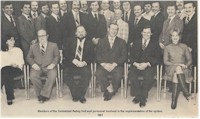 Seated from the left: Specialist Lisette Schweiger; Willie Druin, Supervisor; Robert Viau, Manager Cargo Services; Ray Dicaire, Manager, Centralized Rating Unit; Jean Forget, Supervisor and Mavis Kruhelnisky, Specialist. Seated from the left: Specialist Lisette Schweiger; Willie Druin, Supervisor; Robert Viau, Manager Cargo Services; Ray Dicaire, Manager, Centralized Rating Unit; Jean Forget, Supervisor and Mavis Kruhelnisky, Specialist.
Standing from the left: Specialists; Lutfur Osman, Charles Manuel, Ed Bownes, Manager, Cargo Training Program Development; Barry Woidla, Frank De Vincenzo, Michel Seinet, Marian Terlecki, Denis Perrier, Pierre Riel, Steve McMahon, Marc Larent, Joseph Wojtczak, Urs Wiesendanger, Michel Auger (Acting), Stan Moskoske, Daniel Blanchette, Gaetan Lavoie, Phil Mayoh and Denise Belec.
The unit was formed in January 1980. The company became the first major airline to tackle the serious industry problem of cargo rating errors.
|
|
|
From the "New Horizons" magazine issue dated September 2004. (Used with permission)
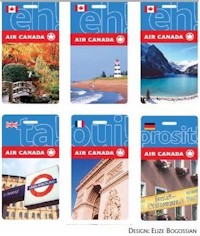 Two of the items to be introduced during the fall of 2004 to energize the Hospitality class; one of the innovations includes baggage tags which will be handed out to overseas passengers at the end of a flight. They had been designed by Air Canada Multimedia. Two of the items to be introduced during the fall of 2004 to energize the Hospitality class; one of the innovations includes baggage tags which will be handed out to overseas passengers at the end of a flight. They had been designed by Air Canada Multimedia.
|
|
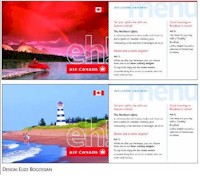 Another innovation is the postcard menus. The left portion separates from the menu and becomes a postcard. These are two of the eight postcards designed in-house. Another innovation is the postcard menus. The left portion separates from the menu and becomes a postcard. These are two of the eight postcards designed in-house.
|
|
|
Customer Service Agents at Frankfurt are pictured here in 2004.
 From the left: Silvia Rosa Dos Santos Daude, Ilsa Berger, Michal Nadjar and Dors Kohler. From the left: Silvia Rosa Dos Santos Daude, Ilsa Berger, Michal Nadjar and Dors Kohler.
|
|
|
From the TCA "In Flight" magazine Vol 5, No 3 issued 1962.
Born on April 10th, 1937, the new airline, a Crown Corporation was incorporated. Originally it was proposed that both public and private capital be invested to create a national air carrier, but the Canadian Pacific Railway, which was invited to share in the enterprise, withdrew and left the Canadian Government to go it alone. TCA was thus created as a wholly-owned subsidiary of the government-owned Canadian National Railway, with an authorized capital of $5,000,000.
 TCA began business with a very modest fleet, two 10-passenger Lockheed 10A Electras (CF-BAF, CF-TCA and CF-TCB) and a single-engine Stearman biplane (CF-ASF), obtained by buying out Canadian Airways Limited. Actual service began on September 1st, 1937 when one of TCA's Lockheeds flew from Seattle airport to Vancouver. TCA inaugurated AirExpress flights between Winnipeg and Vancouver on September 19th, 1938. TCA began business with a very modest fleet, two 10-passenger Lockheed 10A Electras (CF-BAF, CF-TCA and CF-TCB) and a single-engine Stearman biplane (CF-ASF), obtained by buying out Canadian Airways Limited. Actual service began on September 1st, 1937 when one of TCA's Lockheeds flew from Seattle airport to Vancouver. TCA inaugurated AirExpress flights between Winnipeg and Vancouver on September 19th, 1938.
On April 1st, 1939, TCA began carrying passengers Vancouver to Montreal, with intermediate stops, using the Lockheed 14H's or "Super Electras". At Stevenson Field, Winnipeg the first TCA stewardess training took place. TCA's first aircraft, a single-seater Stearman, acquired in 1937.
|
|
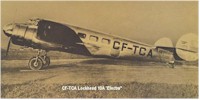 The twin-engine Lockheed 10A 'Electra", one of five used on TCA's first air route, between Vancouver and Seattle 1937. The twin-engine Lockheed 10A 'Electra", one of five used on TCA's first air route, between Vancouver and Seattle 1937.
|
|
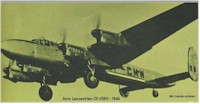 Converted Lancaster Bombers, renamed Lancastrians, were used by TCA, 1943-46, to fly VIP's and war effort equipment to the U.K.. Converted Lancaster Bombers, renamed Lancastrians, were used by TCA, 1943-46, to fly VIP's and war effort equipment to the U.K..
|
|
 Following World War II, TCA put a fleet of 30 twin-engine, 21-passenger Douglas DC-3's. Following World War II, TCA put a fleet of 30 twin-engine, 21-passenger Douglas DC-3's.
|
|
 One of three Bristol Freighters which TCA put into service in 1953 to provide all cargo flights in Canada. One of three Bristol Freighters which TCA put into service in 1953 to provide all cargo flights in Canada.
|
|
 Work-horse of the TCA fleet for 14 years was the North Star, a Canadian-designed aircraft which went into service in 1947. Work-horse of the TCA fleet for 14 years was the North Star, a Canadian-designed aircraft which went into service in 1947.
|

